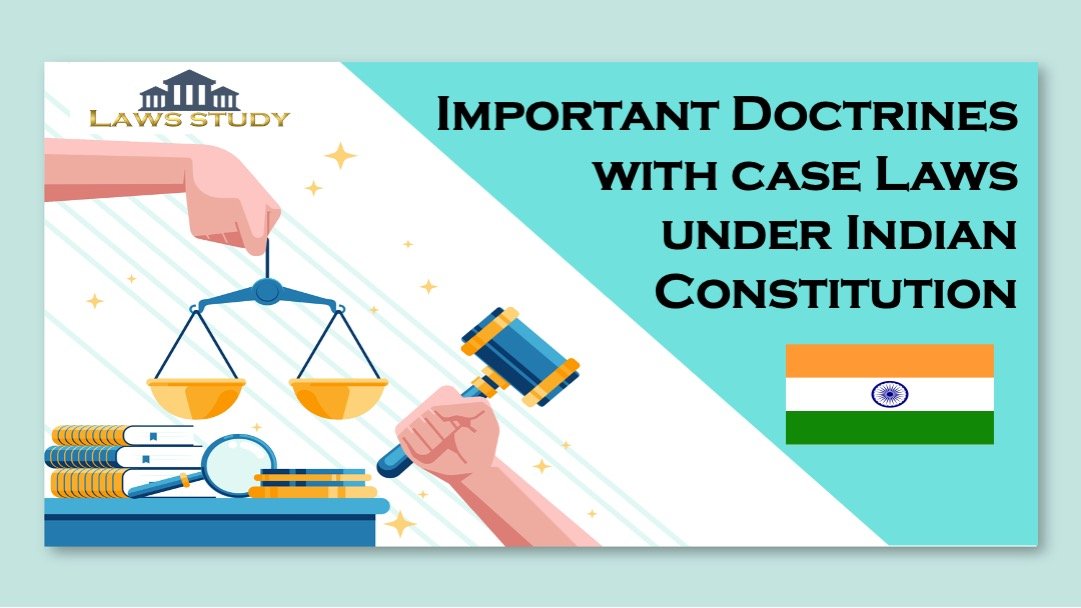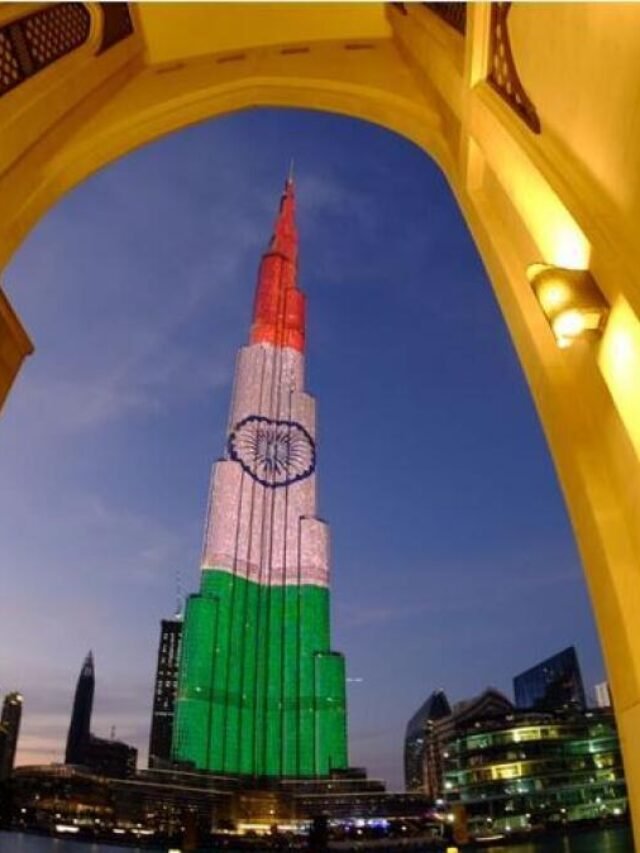The Indian Constitution is one of the lengthiest and most comprehensive constitutions in the world, containing various doctrines that serve as guiding principles for governance in the country. Here are some of the Important Doctrines with case Laws under the Indian Constitution:
Rule of Law
The rule of law is a fundamental doctrine under the Indian Constitution, which means that every citizen is equal before the law, and no one is above the law. It implies that the government must operate within the limits of the law and that the courts are the ultimate arbiters of justice.
The Rule of Law is a fundamental doctrine under the Indian Constitution, which means that every citizen is equal before the law, and no one is above the law. Here is an example of a case law that highlights the importance of the Rule of Law doctrine:
Case Law
Keshavananda Bharati vs. State of Kerala (1973)
In the landmark case of Keshavananda Bharati vs. the State of Kerala, the Supreme Court of India upheld the doctrine of the Rule of Law as a basic feature of the Indian Constitution. The case challenged the Kerala government’s attempt to introduce land reforms that involved the acquisition of large landholdings held by religious institutions.
The petitioner, Keshavananda Bharati, argued that the land reforms violated his fundamental rights and challenged the Kerala government’s authority to make such reforms. The case went before a larger bench of the Supreme Court, which ruled that the Constitution’s basic structure could not be amended, and that the Rule of Law was an essential feature of the Constitution.
The Court held that the Rule of Law requires that the government must act within the limits of the law and that no law can be made or enforced that is inconsistent with the Constitution’s provisions. The Court also stated that the Constitution was the supreme law of the land, and all organs of the government, including the legislature and the executive, were bound by it.
The Keshavananda Bharati case is considered a landmark judgment in Indian constitutional law as it firmly established the doctrine of the Rule of Law and its importance in protecting citizens’ fundamental rights. It also limited the government’s power to amend the Constitution and emphasized the importance of the Constitution as the ultimate source of authority in the country.
Separation of Powers
The Indian Constitution provides for a clear separation of powers between the legislature, the executive, and the judiciary. This doctrine ensures that no one organ of the government can exercise absolute power, and each organ has a defined scope and function.
The Separation of Powers is a fundamental doctrine under the Indian Constitution, which provides for a clear separation of powers between the legislature, the executive, and the judiciary. Here are a few examples of case laws that highlight the importance of the Separation of Powers doctrine:
Kesavananda Bharati v. State of Kerala (1973)
In this landmark case, the Supreme Court of India upheld the Separation of Powers doctrine as a basic feature of the Constitution. The case challenged the Kerala government’s attempt to introduce land reforms that involved the acquisition of large landholdings held by religious institutions. The petitioner argued that the land reforms violated his fundamental rights and challenged the government’s authority to make such reforms. The Court held that the Constitution’s basic structure could not be amended, and the Separation of Powers was an essential feature of the Constitution.
Ram Jawaya Kapur v. State of Punjab (1955)
In this case, the Supreme Court of India emphasized the importance of the Separation of Powers doctrine by stating that the three organs of the government must function within their respective spheres and should not interfere with each other’s functioning. The Court held that the Constitution had established a system of checks and balances between the organs of the government to prevent any abuse of power.
S.R. Bommai v. Union of India (1994)
In this case, the Supreme Court of India upheld the Separation of Powers doctrine by stating that the Governor of a State cannot dismiss an elected government on the ground of loss of majority unless it is proved on the floor of the House. The Court held that the power to dismiss an elected government lies with the legislative assembly, and the Governor’s actions violated the principles of Separation of Powers.
Indira Nehru Gandhi v. Raj Narain (1975)
In this case, the Supreme Court of India upheld the Separation of Powers doctrine by striking down the 39th Amendment to the Constitution, which introduced a provision allowing the government to curtail the power of the judiciary. The Court held that the Separation of Powers doctrine was an essential feature of the Constitution, and any attempt to tamper with it would violate the Constitution’s basic structure.
These case laws highlight the importance of the Separation of Powers doctrine in ensuring that each organ of the government operates within its defined sphere and does not infringe upon the other’s functions. The doctrine is critical in preventing the concentration of power in a single organ and ensuring that the government functions in a fair and democratic manner.
Parliamentary Sovereignty
Under the Indian Constitution, Parliament is the supreme legislative body, and its decisions are binding on all. This doctrine means that the Parliament has the power to make and unmake any law.
The doctrine of Parliamentary Sovereignty is not as central to the Indian constitutional system as it is to the British system. India has a written constitution, which establishes a system of checks and balances to prevent any one organ of the government from becoming too powerful. However, there have been a few cases where the principle of Parliamentary Sovereignty has been discussed in the Indian context. Here are some examples of case laws that touch upon the doctrine of Parliamentary Sovereignty in India:
Keshavananda Bharati v. State of Kerala (1973)
In this landmark case, the Supreme Court of India held that the Constitution was supreme, and no law passed by Parliament could violate its basic structure. The case challenged the 24th Amendment to the Constitution, which sought to take away the power of the judiciary to review constitutional amendments. The Supreme Court held that the power of judicial review was an essential feature of the Constitution and could not be taken away by Parliament.
S.R. Bommai v. Union of India (1994)
In this case, the Supreme Court of India held that the Constitution was supreme, and the Union government could not dismiss a state government on the ground of loss of majority unless it was proved on the floor of the House. The case challenged the President’s use of Article 356 of the Constitution to dismiss the state government of Karnataka. The Supreme Court held that the President’s actions violated the principles of federalism and Parliamentary Sovereignty and were unconstitutional.
Minerva Mills Ltd. v. Union of India (1980)
In this case, the Supreme Court of India held that Parliament could not amend the Constitution in a way that violated its basic structure. The case challenged the 42nd Amendment to the Constitution, which sought to expand Parliament’s power to amend the Constitution. The Supreme Court held that the amendment violated the Separation of Powers doctrine and the fundamental rights guaranteed by the Constitution.
These cases demonstrate that while the principle of Parliamentary Sovereignty is not absolute in the Indian constitutional system, Parliament does have significant power to make laws. However, Parliament’s power is limited by the Constitution, and the Supreme Court has the authority to strike down any law passed by Parliament that violates the Constitution’s basic structure or fundamental rights.
Judicial Review
The doctrine of judicial review is an essential feature of the Indian Constitution, which empowers the judiciary to review the actions of the legislature and executive and declare them unconstitutional if they violate the Constitution’s provisions.
The doctrine of Judicial Review allows the judiciary to review the actions of the executive and legislative branches of government and determine whether they are consistent with the Constitution. Here are some examples of case laws that have helped establish the doctrine of Judicial Review:
Marbury v. Madison (1803)
This case, decided by the US Supreme Court, is considered the cornerstone of the doctrine of Judicial Review. The case established the principle that the judiciary has the power to strike down laws or executive actions that are unconstitutional. The Supreme Court held that the Constitution is the supreme law of the land and that the judiciary has the duty to ensure that all laws and executive actions are consistent with it.
Kesavananda Bharati v. State of Kerala (1973)
In this case, the Supreme Court of India held that the judiciary has the power to review constitutional amendments and strike them down if they violate the Constitution’s basic structure. The case challenged the 24th Amendment to the Constitution, which sought to take away the power of the judiciary to review constitutional amendments. The Supreme Court held that the power of judicial review was an essential feature of the Constitution and could not be taken away by Parliament.
Roe v. Wade (1973)
In this case, the US Supreme Court held that a state law that banned abortion was unconstitutional. The Court held that a woman’s right to privacy, which is protected by the Due Process Clause of the 14th Amendment, includes the right to choose to have an abortion. The case established the principle that the judiciary has the power to strike down laws that violate constitutional rights.
These case laws demonstrate the importance of the doctrine of Judicial Review in ensuring that the government’s actions are consistent with the Constitution. The judiciary serves as a check on the power of the executive and legislative branches of government, ensuring that they do not violate the rights of citizens or exceed their constitutional authority.
Fundamental Rights
The Constitution guarantees fundamental rights to all citizens, which include the right to equality, freedom of speech and expression, right to life and liberty, and freedom of religion. These rights are enforceable by the courts and are essential for protecting individual liberty and dignity.
Fundamental Rights are those rights that are guaranteed by the Constitution and are considered essential to individual freedom and dignity. Here are some examples of case laws that have helped establish and protect fundamental rights:
Maneka Gandhi v. Union of India (1978)
In this case, the Supreme Court of India held that the right to travel abroad is a fundamental right that is protected by Article 21 (Right to Life and Personal Liberty) of the Constitution. The case challenged the Passport Act, which gave the government the power to impound a passport without giving the passport holder an opportunity to be heard. The Supreme Court held that the government’s actions violated the principles of natural justice and the right to personal liberty.
Gopalan v. State of Madras (1950)
In this case, the Supreme Court of India held that the right to life under Article 21 only means the right to not be deprived of life without due process of law. The Court also held that the other fundamental rights were not interdependent and could be restricted by law. This case established the narrow interpretation of Article 21 and was later overruled in the Maneka Gandhi case.
Kesavananda Bharati v. State of Kerala (1973)
In this case, the Supreme Court of India held that the Constitution’s basic structure cannot be amended by Parliament. The Court held that the fundamental rights guaranteed by the Constitution, such as the Right to Equality, Right to Freedom of Speech and Expression, and Right to Life and Personal Liberty, form a part of the basic structure of the Constitution and cannot be amended.
These cases demonstrate the importance of fundamental rights in protecting individual freedom and dignity. The courts play a crucial role in upholding these rights and ensuring that the government does not violate them.
Directive Principles of State Policy
The Constitution also contains the Directive Principles of State Policy, which are guidelines for the government to promote the welfare of the people and establish a just society. While these principles are not legally enforceable, they serve as a moral imperative for the government to act in the best interests of the people.
The Directive Principles of State Policy (DPSP) is a set of guidelines for the Indian government to follow while making laws and policies. Here are some examples of case laws that have helped establish and protect the DPSP:
Minerva Mills v. Union of India (1980)
In this case, the Supreme Court of India held that the DPSP and the Fundamental Rights are equally important and that the government cannot override the Fundamental Rights while trying to achieve the DPSP. The Court also held that the government’s power to amend the Constitution is limited by the principles of the Constitution’s basic structure, which includes the DPSP.
Olga Tellis v. Bombay Municipal Corporation (1985)
In this case, the Supreme Court of India held that the right to livelihood is a fundamental right that is protected by Article 21 (Right to Life and Personal Liberty) of the Constitution. The case challenged the government’s policy of evicting pavement dwellers in Mumbai. The Court held that the government’s actions violated the DPSP, which directs the government to provide adequate means of livelihood for all citizens.
Bandhua Mukti Morcha v. Union of India (1984)
In this case, the Supreme Court of India held that the government has a duty to ensure that the rights of workers are protected and that they are not exploited by employers. The case challenged the government’s failure to implement laws that protect the rights of bonded laborers. The Court held that the DPSP, which directs the government to ensure that workers are not exploited, must be given effect too.
M.C. Mehta v. Union of India (1986)
In this case, the Supreme Court of India held that the government has a duty to protect the environment and prevent pollution. The case challenged the government’s failure to take action against industries that were causing pollution in the Ganga river. The Court held that the DPSP, which directs the government to protect the environment, must be given effect too.
These cases demonstrate the importance of the DPSP in guiding the government’s policies and actions. The DPSP represents the social and economic goals that the government is committed to achieving, and the courts play a crucial role in ensuring that the government fulfills its duty towards its citizens.
Federalism
The Indian Constitution provides for a federal system of government, with powers divided between the central and state governments. This doctrine ensures that the states have a degree of autonomy and can govern themselves independently.
Here are some examples of case laws that have helped establish and protect federalism in India:
S.R. Bommai v. U.O.I (1994)
In this case, the apex court held that the power to dismiss a state govt U/A 356 (President’s Rule) of the Constitution is not absolute and can be reviewed by the courts. The Court also held that the federal structure of the Constitution can’t be altered by the central govt using Art 356. The case established that federalism is an essential feature of the Indian Constitution and that the central government cannot infringe on the powers of the state governments without due cause.
State of Karnataka v. U.O.I (1977)
In this case, the Supreme Court of India held that the state governments have the power to impose taxes on the sale of goods within their territory, even if the goods are imported from another state. The Court held that the federal structure of the Constitution mandates that the state governments have the power to regulate trade and commerce within their territories.
State of West Bengal v. U.O.I (1963)
In this case, the apex court ruled that the central government cannot delegate its legislative powers to the state governments. The Court held that the Constitution mandates that the central government has the power to make laws on matters listed in the Union List, while the state governments have the authority to enact legislation on matters on the State List.
Kihoto Hollohan v. Zachillhu (1992)
In this case, the Supreme Court of India held that the federal character of the Constitution requires that the state governments have a say in the removal of state legislators. The Court held that the power to remove a legislator should not be left solely in the hands of the central government and that state governments should have a role in the process.
These cases demonstrate the importance of federalism in the Indian Constitution and how the courts play a crucial role in protecting it. Federalism ensures that power is shared between the central government and the state governments and that each level of government has its own sphere of authority.
CONCLUSION
These doctrines are essential features of the Indian Constitution and play a vital role in ensuring good governance and protecting the rights of the citizens.

























